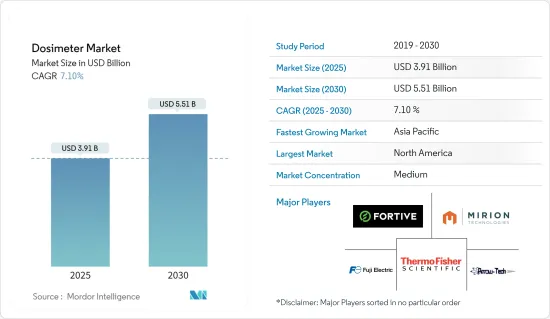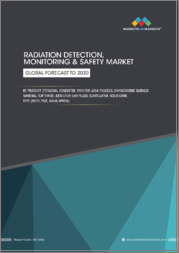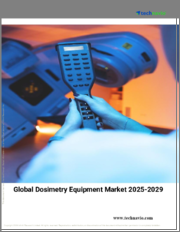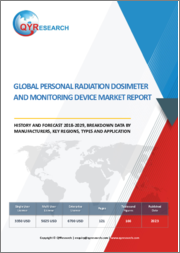
|
시장보고서
상품코드
1687990
선량계 시장 : 시장 점유율 분석, 산업 동향 및 통계, 성장 예측(2025-2030년)Dosimeter - Market Share Analysis, Industry Trends & Statistics, Growth Forecasts (2025 - 2030) |
||||||
선량계 시장 규모는 2025년에 39억 1,000만 달러로 추정되고, 예측 기간 2025년부터 2030년까지 CAGR 7.1%로 성장할 전망이며, 2030년에는 55억 1,000만 달러에 달할 것으로 예측되고 있습니다.

주요 하이라이트
- 선량계는 의료 분야 및 제조 분야를 포함한 다양한 산업에서 다양한 용도가 있습니다. 제조 분야에서는 방사성선원 및 X선 장치의 사용에 의해 장기간에 걸친 방사선피폭을 감시하는 선량계의 요구가 높아지고 있습니다. 필름 배지 및 열 발광 선량계와 같은 수동형 선량계는 제조 분야에서 일상적인 모니터링에 일반적으로 사용됩니다.
- 방사선 관리 및 노동자 안전 확보를 목적으로 하는 정부의 규제가 산업 분야에서 선량계 수요를 끌어올리고 있습니다. 그러나 장비가 비싸고, 전자기장에 민감하고, 기계적으로 불안정한 것 등이 능동형 선량계 시장의 성장을 방해할 수 있습니다.
- 선량계 수요를 뒷받침하는 것은 심혈관 질환, 암, 신경 관련 질환 증가이며 정확한 방사선 모니터링이 필요합니다. 선량계는 핵의학 및 치료용 방사성 의약품에 널리 적용되어 유리한 전망을 보여줍니다. 헬스케어 종사자는 방사선 수준을 분석하기 위해 웨어러블 선량계를 채택합니다.
- 선량계의 기술 향상을 목표로 한 지속적인 연구 개발이 시장 개척에 박차를 가하고 있습니다. 소형화 등의 진보에 의해 보다 소형의 웨어러블 선량계에 의한 실시간 모니터링이 가능하게 되어, 원자력 시설에서 우주 개발까지 다양한 산업에서 이용되고 있습니다.
- 또한 무선 통신 기능을 탑재한 선량계는 원활한 데이터 전송과 원격 감시를 가능하게 하고, 바이오도시메트리와 같은 기술을 도입, 유전적인 편차를 고려한 개별화 선량계 접근법은 방사선 감수성의 개인차를 고려하고 있습니다.
- 전반적으로 선량계 수요는 방사선을 통한 기술의 이용 증가, 정부 규제, 작업자 안전 확보의 필요성 등의 요인에 따라 다양한 산업에서 확대될 것으로 예상됩니다. 그러나 장비 비용이 높고 환경 요인에 민감한 것과 같은 요인으로 인해 시장 성장이 제한될 수 있습니다.
- 2024년 6월, Thermo Fisher Scientific은 방사선 모니터링을 위한 웨어러블 연결 장비인 Thermo Scientific NetDose Pro 디지털 선량계 출시를 발표했습니다. 이 컴팩트한 장비는 헬스케어와 같은 다양한 산업 종업원의 방사선 노출 위험을 추적하고 통지하고 기업이 엄격한 규제 요구 사항을 준수하는 데 도움이 되도록 설계되었습니다.
선량계 시장 동향
산업 분야에서 방사성 물질의 용도 확대가 시장을 견인
- 과학과 산업은 생산성을 향상시키고 재료와 공정에 대한 독특한 인사이트를 제공하는 방사성 동위 원소의 많은 용도를 가지고 있습니다. 방사성 동위 원소는 유체 흐름과 여과 모니터링, 누출 감지, 공정 장비의 엔진 마모 및 부식 측정과 같은 추적기 역할을 합니다. 국제원자력기구(IAEA)에 따르면, 이러한 계기는 세계에서 수십만대 가동하고 있습니다. IAEA에 따르면, 이러한 계기는 세계 수십만대가 가동하고 있습니다.
- 방사성 동위 원소는 또한 다양한 재료의 혼합 및 유량 연구, 금속 부품 검사, 다양한 산업에서 용접의 무결성을 평가하는 데 사용됩니다. 산업용 감마선 검사는 방사선의 투과력을 이용하여 효과적으로 재료를 선별합니다. 공항 보안 점검에 사용되는 X-레이와 유사한 기능을 하지만, 밀봉된 티타늄 캡슐에 작은 방사성 물질 펠렛이 들어 있습니다.
- 또한, 방사성 동위 원소는 원자로의 연료로 발전에 사용되거나 종이, 플라스틱, 금속 시트의 제조시의 두께를 제어하는데 사용되고 있습니다. 또한, 야광 도료나 방사성 발광을 나타내는 물체의 제조에도 사용되고 있습니다.
- 인도는 최근 수십 년간 급속히 산업화가 진행되고 방사선과 유해 가스가 증가하고 있습니다. 많은 산업 및 병원에서 직원 및 의료 전문가의 과도한 방사선 노출을 방지하기 위해 선량 측정 시스템이 도입되었습니다. 이러한 요인들이 인도 시장의 성장을 가속할 것으로 예상됩니다.
- MIT가 발표한 기사에 따르면 2024년 1월 현재 미국에서는 약 70개사가 선진적인 원자로 개발에 임하고 있으며, 그 중 약 7개사가 원자력 프로젝트의 성질상 규제 당국과 협력하고 있습니다. 표준 수냉기술 이외의 대체 원자로 기술에 대한 관심이 높아지고 있습니다.
아시아태평양이 현저한 성장을 이룰 전망
- 아시아태평양은 주로 다양한 최종 사용자 산업에서 방사선 채용이 증가하고 있기 때문에 세계 선량계 시장을 독점할 것으로 예상됩니다. 이 지역은 에너지 수요 증가에 대응하기 위한 발전용 원자력발전에 대한 주목 증가와 중국, 일본, 인도 등 신흥국에서의 인체 안전에 대한 엄격한 규제에 의해 대폭적인 수익 성장이 전망되고 있습니다.
- 엑손모빌은 2040년 아시아태평양의 원자력 수요는 22조 BTU에 이르며 45조 BTU를 차지할 것으로 예측했습니다. 중국원자력에너지협회는 2023년 중국의 원자력발전이 44만 기가와트에 달하였고, 국가 발전량의 5%를 차지했으며 인구의 청정에너지 수요를 충족하기 위해 더욱 증가할 것으로 예측하고 있다고 보고했습니다.
- 세계원자력협회에 따르면 중국은 2030년까지 미국을 제치고 세계 제일의 원자력발전국이 될 전망입니다. 중국에서는 원자력발전소 건설이 증가하고 있어 예측기간 중에 선량계 수요가 높아질 것으로 예상됩니다. 예를 들어 중국은 2024년에 3개의 원자로를 건설하기 시작했으며, 2025년부터 2030년까지 23개의 원자로를 추가로 건설할 계획입니다.
- 중국은 또한 과학기술 계획의 국가계획에 원자력안전의 조사연구를 담아 원자력 및 방사선안전규제를 위한 국가연구개발센터를 설립하여 안전성을 높이기 위한 방사선환경 모니터링과 기술심사의 주요기술 연구를 실시했습니다. 이러한 노력은 예측 기간 동안 중국의 선량계 수요를 견인할 것으로 예상됩니다.
- 일본은 세계 최대급의 고령화 사회를 맞이하고 있으며, 65세 이상의 인구가 상당한 부분을 차지하고 있습니다. 2023년 국가 통계에 따르면 10명 중 1명이 80세 이상이고 인구의 29.5%가 65세 이상입니다. 국립사회보장 및 인구문제연구소의 데이터에 따르면 2040년에는 65세 이상이 인구의 34.8%를 차지하게 될 것으로 예상되고 있습니다. 인구의 고령화는 의료 솔루션 수요를 촉진하고 노년 인구에서 암 이환율 증가는 의료 분야의 선량계 수요에 영향을 미칠 것으로 예상됩니다. 따라서 선량계 시장은 앞으로 수년간 일본 전체에서 확대될 것으로 예상됩니다.
- IEA와 세계원자력협회가 발표한 정보에 따르면 2024년 4월 현재 16개국에서 약 60기의 원자로가 건설 중이며 향후 110기의 원자로가 계획되고 있습니다. 건설 활동 측면에서 아시아는 레이스를 이끌고 있습니다. 약 30개국이 원자로 계획을 계획하거나 시작하고 있습니다.
선량계 산업 개요
선량계 시장에는 Fortive Corporation, Mirion Technologies Inc., Thermo Fisher Scientific Inc., Arrow-Tech Inc., Fuji Electric과 같은 대기업이 존재합니다. 이 회사들은 제품 제공을 강화하고 지속 가능한 경쟁 우위를 확보하기 위해 제휴 및 인수와 같은 전략을 채택합니다.
- 2024년 4월-Mirion Medical 산하의 Mirion Dosimetry Services는 방사선 피폭 모니터링 기능을 강화한 무선 선량계 InstadoseVUE를 발표했습니다. 첨단 무선 기술은 안정적인 연결성, 보다 빠른 데이터 전송, 장시간 배터리 수명을 제공합니다. 또한 전자 디스플레이를 탑재하고 실시간으로 상황을 확인할 수 있습니다. 이 선량계는 언제 어디서나 피폭 선량을 모니터링할 수 있어 전통적인 배지 반송 처리의 필요성을 없애고 컴플라이언스를 간소화합니다.
- 2023년 5월-IBA는 오스트리아 비엔나에서 개최된 유럽 방사선 종양 치료 학회(ESTRO) 연례 총회에서 방사선 치료 품질 보증에 대한 최신 혁신을 발표했습니다.
기타 혜택 :
- 엑셀 형식 시장 예측(ME) 시트
- 3개월간의 애널리스트 서포트
목차
제1장 서론
- 조사 전제조건 및 시장 정의
- 조사 범위
제2장 조사 방법
제3장 주요 요약
제4장 시장 인사이트
- 시장 개요
- 업계의 매력도-Porter's Five Forces 분석
- 공급기업의 협상력
- 구매자의 협상력
- 신규 참가업체의 위협
- 대체품의 위협
- 경쟁 기업간 경쟁 관계의 강도
- 업계 밸류체인 분석
- COVID-19의 후유증과 기타 거시경제 요인이 시장에 미치는 영향
제5장 시장 역학
- 시장 성장 촉진요인
- 의료 분야에서 방사선 및 모니터링 장비에 대한 수요 증가
- 산업 분야에서 방사성 물질의 용도 확대
- 시장 성장 억제요인
- 제품의 정확도, 엄격한 정부 규제 및 높은 비용
제6장 시장 세분화
- 유형별
- 전자식 개인 선량계(EPD)
- 열 발광 선량계(TLD)
- 광자극 루미네센스 선량계(OSL)
- 필름 배지 선량계
- 기타 유형
- 용도별
- 액티브형
- 패시브형
- 최종 사용자 산업별
- 헬스케어
- 석유 및 가스
- 광업
- 원자력 플랜트
- 공업
- 제조업
- 기타 최종 사용자 산업
- 지역별
- 북미
- 유럽
- 아시아
- 호주 및 뉴질랜드
- 라틴아메리카
- 중동 및 아프리카
제7장 경쟁 구도
- 기업 프로파일
- Fortive Corporation
- Mirion Technologies Inc.
- Thermo Fisher Scientific Inc.
- Arrow-Tech Inc.
- Fuji Electric Co. Ltd
- ATOMTEX
- Tracerco Limited
- Automess-Automation and Measurement GmbH
- SE International Inc.
- Radiation Detection Company Inc.
제8장 투자 분석
제9장 시장의 미래
AJY 25.04.07The Dosimeter Market size is estimated at USD 3.91 billion in 2025, and is expected to reach USD 5.51 billion by 2030, at a CAGR of 7.1% during the forecast period (2025-2030).

Key Highlights
- Dosimeters have diverse applications in various industries, including the medical and manufacturing sectors. In the manufacturing sector, using radioactive sources or X-ray machines has increased the need for dosimeters to monitor radiation exposure over an extended period. Passive dosimeters, such as film badges and thermoluminescent dosimeters, are commonly used for routine monitoring in the manufacturing industry.
- Government regulations, which aim to control emissions and ensure labor safety, boost the demand for dosimeters in the industrial sector. However, the device's high cost, sensitivity to electromagnetic fields, and mechanical instability can hinder the growth of the active dosimeter market.
- The demand for dosimeters is propelled by the increasing prevalence of cardiovascular diseases, cancer, and neurology-related conditions, necessitating precise radiation monitoring. Dosimetry equipment finds extensive applications in nuclear medicine and therapeutic radiopharmaceuticals, presenting lucrative prospects. Healthcare practitioners are embracing wearable dosimeters to analyze radiation levels, while the rising use of imaging devices mandates robust radiation exposure monitoring.
- Market growth is further fueled by continuous research and development efforts aimed at enhancing dosimeter technology. Advancements such as miniaturization enable real-time monitoring with smaller, wearable dosimeters, catering to diverse industries from nuclear facilities to space exploration.
- Additionally, dosimeters equipped with wireless communication capabilities facilitate seamless data transfer and remote monitoring, while personalized dosimetry approaches consider individual variations in radiation sensitivity, incorporating techniques like biodosimetry and accounting for genetic variability.
- Overall, the demand for dosimeters is expected to grow in various industries, driven by factors such as the increasing use of radiation-mediated technology, government regulations, and the need for worker safety. However, market growth may be limited by factors such as the high cost of the device and its sensitivity to environmental factors.
- In June 2024, Thermo Fisher Scientific announced the launch of the Thermo Scientific NetDose Pro digital dosimeter, a wearable, connected device for monitoring radiation. This compact instrument is designed to track and inform radiation exposure risk for personnel in a variety of industries, such as healthcare, and help companies adhere to stringent regulatory requirements.
Dosimeter Market Trends
The Rising Application of Radioactive Substances Across the Industrial Sector is Driving the Market
- Science and industry have numerous applications for radioisotopes that improve productivity and provide unique insights into materials and processes. Radioisotopes serve as tracers to monitor fluid flow and filtration, detect leaks, and gauge engine wear and corrosion of process equipment. According to the International Atomic Energy Agency (IAEA), several hundred thousand such gauges are operating worldwide. They are used to measure the amount of radiation absorbed in materials.
- Radioisotopes are also used to study the mixing and flow rates of various materials, inspect metal parts, and assess the integrity of welds across a range of industries. Industrial gamma radiography utilizes the penetrating power of radiation to screen materials effectively. It works similar to X-rays used in airport security checks but with a small pellet of radioactive material in a sealed titanium capsule.
- In addition, radioisotopes are used as fuel in nuclear reactors to generate power and control the thickness of paper, plastic, and metal sheets during manufacturing. They are also used to manufacture luminescent paints and objects that exhibit radio-luminance.
- India has seen rapid industrialization in recent decades, leading to increased radiation and harmful gases. Dosimetry systems are being installed to prevent excessive radiation exposure to employees and healthcare professionals in many industries and hospitals. These factors are expected to propel the growth of the market in India.
- As of January 2024, approximately 70 companies in the United States were working on advanced nuclear reactors, of which around 7 companies were working with regulators due to the nature of the nuclear project, based on an article published by MIT. The interest in alternative nuclear reactor technology, besides the standard water-cooled technology, has increased.
Asia-Pacific is Expected to Witness Significant Growth
- Asia-Pacific is expected to dominate the global dosimeter market, primarily due to the increasing adoption of radiation across various end-user industries. The region is anticipated to witness significant revenue growth, driven by the growing focus on nuclear power for electricity generation to meet the rising energy demands and stringent regulations for human safety in emerging countries such as China, Japan, and India.
- Exxon Mobil estimates that 2040 nuclear energy demand in the Asia-Pacific region will reach 22 quadrillion BTUs, accounting for 45 quadrillion BTUs. China Nuclear Energy Association reported that in 2023, China's nuclear power generation reached 440,000 gigawatt-hours, accounting for 5% of the nation's electricity output, and it is expected to increase further to meet the population's clean energy demand.
- According to the World Nuclear Association, China is on track to become the world's leading producer of nuclear energy by 2030, surpassing the United States. The increasing construction of nuclear power plants in China is expected to boost dosimeter demand over the forecast period. For instance, in 2024, China started the construction of 3 nuclear reactors, and the country has planned the additional construction of 23 nuclear reactors from 2025 to 2030.
- China also included R&D in nuclear safety in their national planning for scientific and technological programs, established a National Research and Development Center for Nuclear and Radiation Safety Regulation, and conducted research on key technologies of radiation environment monitoring and technical review to enhance safety. These initiatives are expected to drive dosimeter demand in China during the forecast period.
- Japan has one of the world's largest aging populations, with a significant portion being over 65 years old; this population is expected to rise substantially by 2060. According to the 2023 national statistics, 1 out of 10 people were aged 80 or above, while 29.5% of the population was 65 or above. Those aged above 65 are expected to account for 34.8% of the population by 2040, based on data provided by the National Institute of Population and Social Security Research. The aging population is likely to drive demand for healthcare solutions, and the rise in cancer incidence in the geriatric population will affect the demand for dosimeters from the healthcare sector. Hence, the dosimeter market is expected to expand across Japan in the coming years.
- As of April 2024, based on the information published by the IEA and World Nuclear Association, there were about 60 nuclear reactors under construction in 16 countries, along with 110 nuclear reactors planned for the future. Asia is leading the race in terms of construction activities. About 30 countries are planning or starting a nuclear reactor program.
Dosimeter Industry Overview
The dosimeter market is semi-consolidated, with the presence of major players such as Fortive Corporation, Mirion Technologies Inc., Thermo Fisher Scientific Inc., Arrow-Tech Inc., and Fuji Electric Co. Ltd. These players are adopting strategies such as partnerships and acquisitions to enhance their product offerings and gain sustainable competitive advantage.
- April 2024: Mirion Dosimetry Services, a Mirion Medical company, unveiled the InstadoseVUE wireless dosimeter, offering enhanced radiation exposure monitoring. Advanced wireless technology allows it to ensure stable connectivity, faster data transmission, and prolonged battery life. The device features an electronic display for real-time insights and status updates. The dosimeter simplifies compliance with its anytime, anywhere dose monitoring, eliminating the need for traditional badge return processing.
- May 2023: IBA presented the latest innovations from its radiation therapy Quality Assurance offering at the European Society for Therapeutic Radiology and Oncology (ESTRO) Annual Meeting held in Vienna, Austria.
Additional Benefits:
- The market estimate (ME) sheet in Excel format
- 3 months of analyst support
TABLE OF CONTENTS
1 INTRODUCTION
- 1.1 Study Assumptions and Market Definition
- 1.2 Scope of the Study
2 RESEARCH METHODOLOGY
3 EXECUTIVE SUMMARY
4 MARKET INSIGHTS
- 4.1 Market Overview
- 4.2 Industry Attractiveness - Porter's Five Forces Analysis
- 4.2.1 Bargaining Power of Suppliers
- 4.2.2 Bargaining Power of Buyers
- 4.2.3 Threat of New Entrants
- 4.2.4 Threat of Substitute Products
- 4.2.5 Intensity of Competitive Rivalry
- 4.3 Industry Value Chain Analysis
- 4.4 Impact of COVID-19 After-effects and Other Macroeconomic Factors on the Market
5 MARKET DYNAMICS
- 5.1 Market Drivers
- 5.1.1 Growing Demand for Radiation and Monitoring Devices Across the Medical Sector
- 5.1.2 Rising Application of Radioactive Substances Across the Industrial Sector
- 5.2 Market Restraint
- 5.2.1 Product Accuracy, Stringent Government Regulations, and High Costs
6 MARKET SEGMENTATION
- 6.1 By Type
- 6.1.1 Electronic Personal Dosimeter (EPD)
- 6.1.2 Thermo Luminescent Dosimeter (TLD)
- 6.1.3 Optically Stimulated Luminescence Dosimeters (OSL)
- 6.1.4 Film Badge Dosimeter
- 6.1.5 Other Types
- 6.2 By Application
- 6.2.1 Active
- 6.2.2 Passive
- 6.3 By End-user Industry
- 6.3.1 Healthcare
- 6.3.2 Oil and Gas
- 6.3.3 Mining
- 6.3.4 Nuclear Plants
- 6.3.5 Industrial
- 6.3.6 Manufacturing
- 6.3.7 Other End-user Industries
- 6.4 By Geography
- 6.4.1 North America
- 6.4.2 Europe
- 6.4.3 Asia
- 6.4.4 Australia and New Zealand
- 6.4.5 Latin America
- 6.4.6 Middle East and Africa
7 COMPETITIVE LANDSCAPE
- 7.1 Company Profiles
- 7.1.1 Fortive Corporation
- 7.1.2 Mirion Technologies Inc.
- 7.1.3 Thermo Fisher Scientific Inc.
- 7.1.4 Arrow-Tech Inc.
- 7.1.5 Fuji Electric Co. Ltd
- 7.1.6 ATOMTEX
- 7.1.7 Tracerco Limited
- 7.1.8 Automess - Automation and Measurement GmbH
- 7.1.9 SE International Inc.
- 7.1.10 Radiation Detection Company Inc.


















